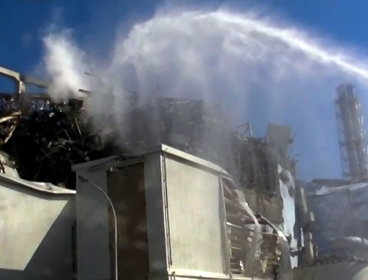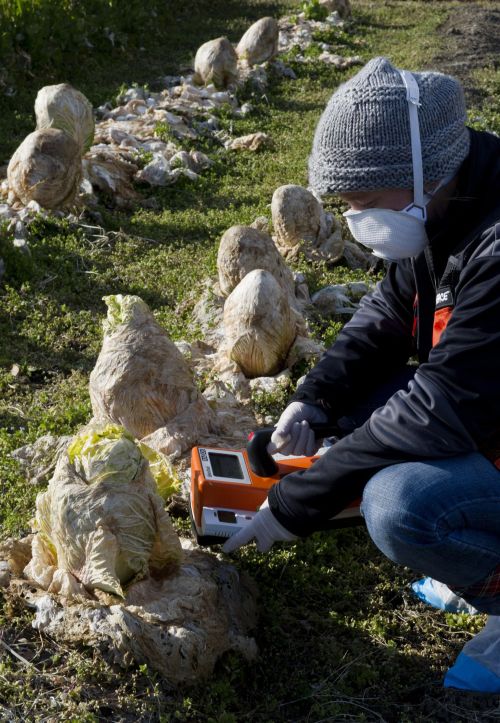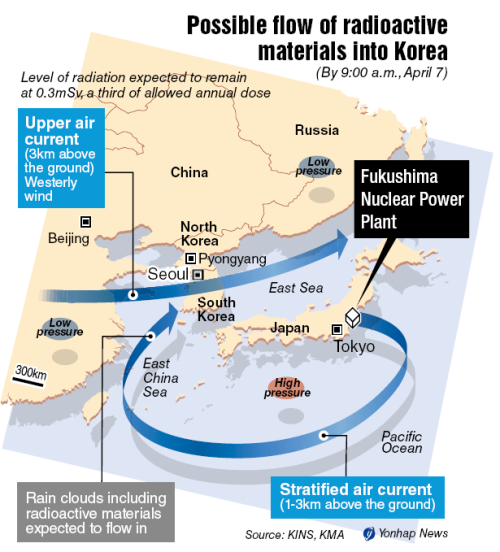
Radioactive water leak into sea stops at Fukushima
TOKYO (AFP) - A leak of highly radioactive water into the Pacific Ocean from Japan's crippled Fukushima nuclear plant was stopped Wednesday, the operator Tokyo Electric Power Co. (TEPCO) announced.
"Workers confirmed at 5:38 am (2038 GMT) that the water running off out of a pit had stopped," the embattled operator said in a statement.
TEPCO had on Tuesday injected sodium silicate, a chemical agent known as "water glass", to solidify soil near a cracked pit, from where highly radioactive water had been seeping through and running into the sea.
The water had been found to have a radiation level of more than 1,000 millisieverts and is believed to be the source of spiking radioactive
iodine-131 readings more than 4,000 times the legal limit in ocean waters.
The pit, which has a 20-centimetre crack in its wall, is linked to the plant's reactor No. 2, one of those which had its cooling systems put out of action by the quake and tsunami of March 11, triggering the nuclear crisis.
Several unsuccessful attempts had been made to try to plug pipes that run to the pit, using a polymer and even newspapers and sawdust, and an effort to seal the crack with cement had also failed to stop the leak.
Separately, TEPCO has been pumping low-level radioactive water into the sea to free up urgently needed safe storage space for water so toxic that it is halting crucial repair work.
<한글 기사>
도쿄전력 "고농도 오염수 바다 유출 멈춰"
도쿄전력은 후쿠시마(福島) 제1원자력발전소 2호기 부근 전력케이블 시설에서 고농도 오염수 바다 유출이 멈췄다고 6일 발표했 다.
도쿄전력은 고농도 오염수가 고여 있던 2호기 부근 전력케이블 시설의 균열을 특수 약제(고화제)를 주입해 굳힌 결과 이날 오전 5시38분께 오염수의 바다 유출이 멈춘 것을 확인했다고 설명했다.
도쿄전력은 일단 2호기 부근의 전력케이블 시설로부터의 고농도 오염수 유출을 차단함에 따라 다른 곳에서도 오염수의 누출이 있는지 확인하기로 했다.
도쿄전력은 지난 2일 고농도 오염수가 바다로 직접 유출되는 것을 발견한 뒤 4 일째 이를 차단하기 위해 계속 작업해왔다.
(연합뉴스)
日원전 방사성 고농도 오염수 총량은 6만t
후쿠시마(福島) 제1원자력발전소에 미처리 상태로 고여있는 고농도 방사성 물질 오염수의 총량이 6만t에 달하는 것으로 나타났다.
교도통신에 따르면 일본 원자력안전보안원은 5일 후쿠시마 제1원전 1∼3호기의 터빈건물과 작업터널 등에 고여있는 고농도 방사성 물질 오염수가 약 6만t으로 추정 된다고 밝혔다.
도쿄전력은 이 고농도 오염수 가운데 3만t은 원전 내에 있는 폐기물집중처리시설 등으로 옮기고 나머지는 시즈오카(靜岡)시에서 빌린 대형부유식구조물(메가플로트)과 가설탱크 등에 보관할 방침이다.
이미 방사성 물질을 가장 많이 품고 있는 2호기 터빈실의 오염수 가운데 약 3천 t을 복수기로 옮겼다.
한편 도쿄전력은 바다로 버리기로 한 저농도 오염수 1만1천500t 가운데 3천400t 을 이날 정오까지 방출했다.
에다노 유키오(枝野幸男) 관방장관은 이날 오전 기자회견에서 "보다 큰 피해를 막기 위해 저농도 오염수의 바다 방출을 승인했다"고 말했다.
가이에다 반리(海江田万里) 경제산업상은 "상상외다. 이번을 끝으로 오염수를 바다로 방출하는 일이 없었으면 좋겠다. 불가피한 조치지만 어민과 국민에게 큰 심려를 끼쳤다. 사죄하고 싶다"고 고개를 숙였다.
(연합뉴스)
S. Korea concerned over Japan’s dumping of contaminated water
Winds expected to blow radioactive materials here by Thursday
Seoul objected to Japan’s discharge of some 11,500 tons of highly radioactive contaminated water into the ocean Monday amid fears that so much radioactive water could endanger marine life and contaminate the human food chain.
The South Korean Foreign Ministry said it expressed concerns through its embassy in Japan that unleashing the contaminated water with radiation levels 100 times higher than the legally permitted level could infringe on international law and inquired about Tokyo’s next steps.
The Japanese foreign ministry replied that it will leak the contaminated water in small amounts over five days and measure the radiation levels in nearby waters as it continues to discharge. Tokyo also said it will reconsider the discharge once the detected levels exceed the legally permitted amount and look into whether it is against international law, according to Seoul officials.
Tokyo Electric Power Co., which runs the crippled Fukushima Daiichi nuclear power plant, began releasing excess water that has collected at the nuclear facility into the sea Monday evening. Most of the dumped water, 10,000 tons, will come from the plant’s central waste treatment unit which will then be used to store highly radioactive water from the No. 2 reactor.
The concentration of radioactive iodine in the discharged water is about 100 times the legally permitted amount. The power company dismissed concerns, however, saying the amount of radioactive materials an adult could intake by eating fish and seaweed from around the plant every day for a year would be 0.6 millisieverts, lower than the 1 millisievert exposure level set by the government.


Experts around the world say that the radiation will be quickly diluted in the Pacific Ocean, although it could have some negative effect on the sea life near the nuclear plant.
The discharged water’s concentration of radioactive iodine-131 is 6.3 becquerels per cubic centimeter, which is more than triple the radioactivity permitted in food.
International law such as the United Nations Convention on the Law of the Sea and the London Convention ban pollution of the sea by dumping, but provides no set criteria for the amount of contamination allowed to be discharged.
The UNCLOS Article 210 stipulates that states “shall adopt laws and regulations to prevent, reduce and control pollution of the marine environment by dumping” and that such laws “shall ensure that dumping is not carried out without the permission of the competent authorities of States.”
South Korea and Japan have signed an agreement on the peaceful use of nuclear power last December, but the agreement contains no regulation on discharge of radioactive materials into the sea.
A top Japanese official apologized Tuesday for dumping the radioactive water into the sea, acknowledging the damage on fishermen but said it was a necessary evil to avoid even more problems and contamination outside the embattled nuclear facility.
“The water contains a high level of radiation,” Chief Cabinet Secretary Yukio Edano said of the liquid being dumped. “We are sorry for this decision we have to make.”
Meanwhile, winds containing radioactive materials from the Fukushima plant are expected to reach South Korea on Thursday accompanied by heavy rain although the concentration level of radioactive materials reaching Korea will be almost negligible, state-run agencies said.
By Kim So-hyun (sophie@heraldcorp.com)







![[Graphic News] More Koreans say they plan long-distance trips this year](http://res.heraldm.com/phpwas/restmb_idxmake.php?idx=644&simg=/content/image/2024/04/17/20240417050828_0.gif&u=)
![[KH Explains] Hyundai's full hybrid edge to pay off amid slow transition to pure EVs](http://res.heraldm.com/phpwas/restmb_idxmake.php?idx=644&simg=/content/image/2024/04/18/20240418050645_0.jpg&u=20240419100350)





![[From the Scene] Monks, Buddhists hail return of remains of Buddhas](http://res.heraldm.com/phpwas/restmb_idxmake.php?idx=652&simg=/content/image/2024/04/19/20240419050617_0.jpg&u=20240419175937)

![[KH Explains] Hyundai's full hybrid edge to pay off amid slow transition to pure EVs](http://res.heraldm.com/phpwas/restmb_idxmake.php?idx=652&simg=/content/image/2024/04/18/20240418050645_0.jpg&u=20240419100350)

![[Today’s K-pop] Illit drops debut single remix](http://res.heraldm.com/phpwas/restmb_idxmake.php?idx=642&simg=/content/image/2024/04/19/20240419050612_0.jpg&u=)